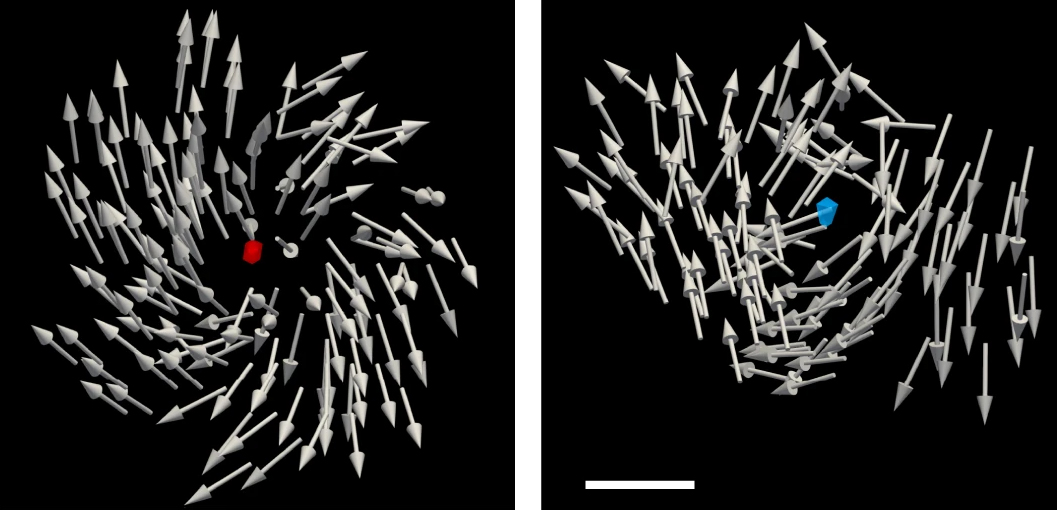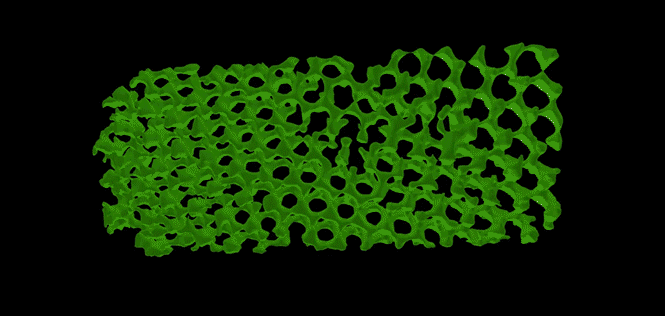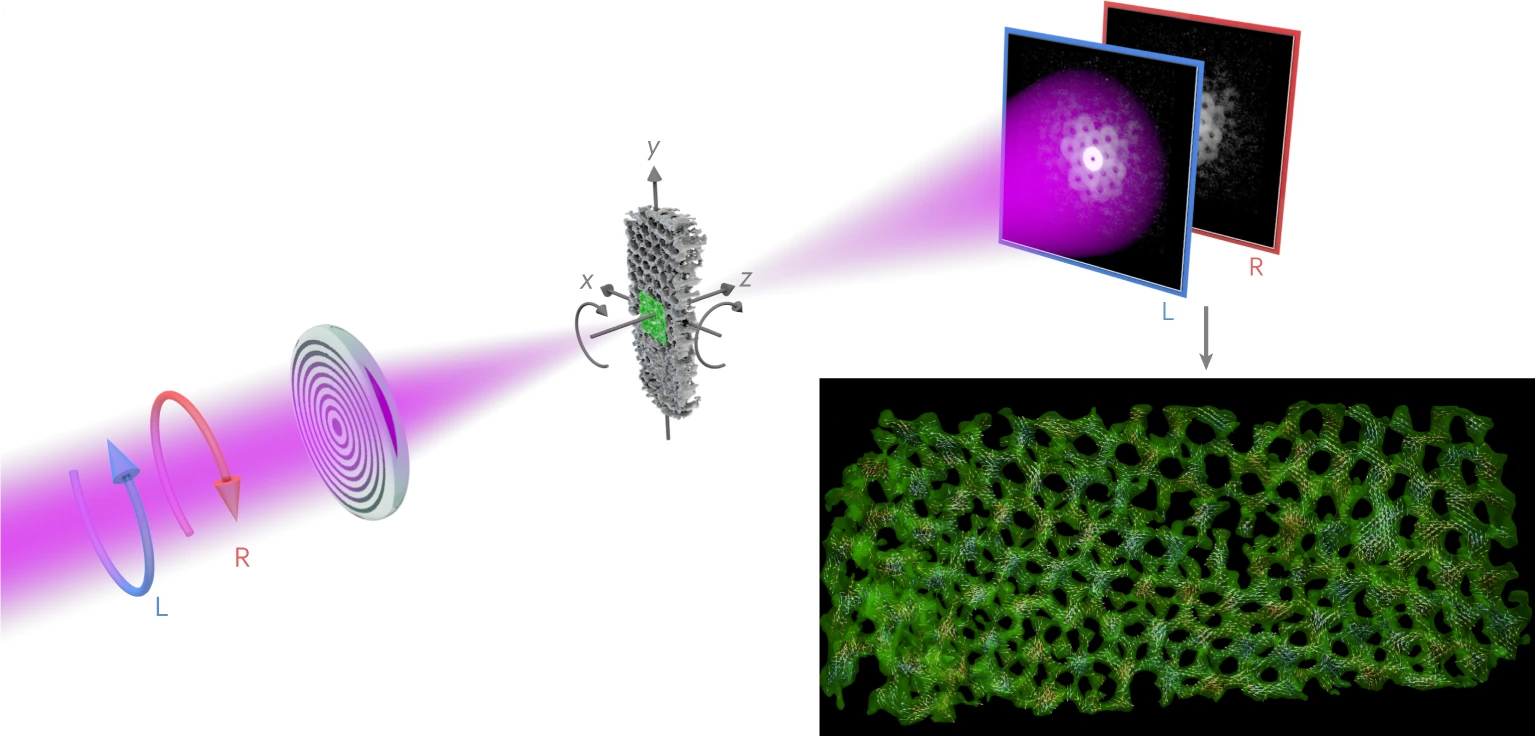SCIENTIFIC ACHIEVEMENT
Researchers created topologically stable magnetic monopoles and imaged them in 3D with unprecedented spatial resolution using a technique developed at the Advanced Light Source (ALS).
SIGNIFICANCE AND IMPACT
The work enables the study of magnetic monopole behavior for both fundamental interest and potential use in information storage and transport applications.

Capturing the elusive monopole
A bar magnet cut in half will always have a north and south pole, ad infinitum. Thus, magnetic monopoles—particles with a single magnetic “charge”—have never been observed in isolation. Yet the idea continues to intrigue: How would magnetic monopoles behave? What could you do with the magnetic equivalent of electric charge or current? Remarkably, scientists might be able to explore such questions via quasiparticles—particle-like phenomena emerging from collective interactions in condensed matter. However, it has been difficult to directly measure these quasiparticles and probe their behavior at the nanoscale.
In this work, researchers report on the synthesis of a specially nanostructured magnetic material containing topologically stable, room-temperature magnetic monopoles. Furthermore, to study such materials, they developed a powerful coherent diffractive imaging technique capable of capturing magnetic textures in 3D with high spatial resolution. The collaboration involved a partnership between the Department of Energy (DOE) and the National Science Foundation (NSF), through the NSF Science and Technology Center on Real-Time Functional Imaging (STROBE).
Hedgehogs in a meta-lattice
Topological magnetic monopoles (TMMs) are sometimes called hedgehogs because they are surrounded by magnetization vectors that radiate outward, like hedgehog spines. Depending on the direction of the corresponding magnetic field lines (source or sink), monopoles can be positive (TMMs) or negative (anti-TMMs). They are also non-local (i.e., can affect spin states far away) and topologically robust against thermal and quantum fluctuations.
To host the TMMs, the researchers synthesized a material composed of silicon nanospheres embedded in nickel. The interstitial spaces between the nanospheres, filled with ferromagnetic nickel, form a meta-lattice of octahedral and tetrahedral sites connected by thin necks. This complex 3D curved surface induces strong frustration in the ferromagnetic meta-lattice, which can stabilize TMMs (and anti-TMMs) in the octahedral and tetrahedral sites.

Vector ptycho-tomography at COSMIC
To determine the magnetization vectors and emergent magnetic fields of the TMMs, the researchers developed a powerful imaging method at ALS Beamline 7.0.1.2 (COSMIC). The technique—soft x-ray vector ptycho-tomography—uses coherent diffraction patterns recorded from overlapping fields of left- and right-circularly polarized light, at several different sample tilt angles. About 800,000 diffraction patterns were collected (several terabytes of data), and powerful computational algorithms were developed to analyze the data.
The 10-nm resolution of the resulting 3D images is comparable to the magnetic exchange length of transition metals, enabling the study of monopole-monopole interactions. Previous studies used either 2D imaging techniques or 3D imaging at a spatial resolution 5 to 10 times lower. In their sample, the researchers identified 68 TMMs and 70 anti-TMMs at room temperature, with oppositely polarized TMM pairs stabilized closer together than similarly polarized TMMs.
The work demonstrates that ferromagnetic meta-lattices could be used as a platform for investigating the interactions and dynamics of magnetic monopoles for potential use in information storage and transport applications. Furthermore, the 3D spatial resolution of vector ptycho-tomography can be improved by increasing the data acquisition time or the incident coherent flux, and thus will benefit from the rapid development of advanced synchrotron sources worldwide.

Contact: John Miao
Researchers: A. Rana, M. Pham, Y.H. Lo, W. Liu, C.M. O’Leary, S.J. Osher, and J. Miao (UCLA; Univ. of Colorado, Boulder; and NIST); C.-T. Liao, E.-E. Cating Subramanian, S.A. Ryan, C.S. Bevis, R.M. Karl Jr, H.C. Kapteyn, and M.M. Murnane (Univ. of Colorado, Boulder; and NIST); E. Iacocca (Northumbria Univ., UK; and Univ. of Colorado, Colorado Springs); X. Lu (UCLA and Soochow Univ., China); A.J. Glaid, J. Rable, V.H. Crespi, and J.V. Badding (Penn State Univ.); P. Mahale and T.E. Mallouk (Penn State Univ. and Univ. of Pennsylvania); J. Hirst (Sheffield Hallam Univ., UK); T. Ostler (Sheffield Hallam Univ. and Univ. of Hull, UK); Y.-S. Yu, H. Ohldag, and D.A. Shapiro (ALS); K. Bustillo (Berkeley Lab); S. Yazdi (Univ. of Colorado, Boulder); and J. Zou and Y. Tserkovnyak (UCLA).
Funding: National Science Foundation; U.S. Department of Energy, Office of Science, Basic Energy Sciences program (DOE BES); Army Research Office; DARPA; and Univ. of Colorado, Colorado Springs. Operation of the ALS and Molecular Foundry is supported by DOE BES.
Publication: A. Rana, C.-T. Liao, E. Iacocca, J. Zou, M. Pham, X. Lu, E.-E. Cating Subramanian, Y.H. Lo, S.A. Ryan, C.S. Bevis, R.M. Karl Jr, A.J. Glaid, J. Rable, P. Mahale, J. Hirst, T. Ostler, W. Liu, C.M. O’Leary, Y.-S. Yu, K. Bustillo, H. Ohldag, D.A. Shapiro, S. Yazdi, T.E. Mallouk, S.J. Osher, H.C. Kapteyn, V.H. Crespi, J.V. Badding, Y. Tserkovnyak, M.M. Murnane, and J. Miao, “Three-dimensional topological magnetic monopoles and their interactions in a ferromagnetic meta-lattice,” Nat. Nanotechnol. 18, 227 (2023), doi:10.1038/s41565-022-01311-0.
ALS SCIENCE HIGHLIGHT #479